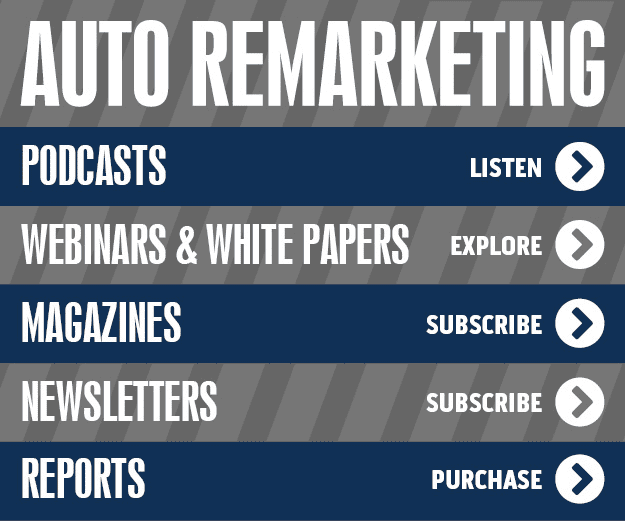Off lease ‘glut’ — are we there yet?

By subscribing, you agree to receive communications from Auto Remarketing and our partners in accordance with our Privacy Policy. We may share your information with select partners and sponsors who may contact you about their products and services. You may unsubscribe at any time.
CARY, N.C. –
Unless you’ve been living under a 2-ton truck, you likely haven’t missed the news that leasing hit a high during the first quarter this year, surpassing 30 percent of all new-vehicle transactions.
Given that information, you’ve likely thought about what happens as all these off-lease vehicles start returning to the market in droves.
Here at Auto Remarketing, we’ve been thinking a lot about this, too, asking such questions as: “How will this affect used-car pricing?” And even, “Should we panic?”
We recently spoke with Andrew Stuart, president and chief executive officer of TD Auto Finance, to get his take on the matter.
“I’ve been in this business my entire career. I’ve seen a lot of cycles come and go,” Stuart said.
Read: He’s got some insight to lend.
Subscribe to Auto Remarketing to stay informed and stay ahead.
By subscribing, you agree to receive communications from Auto Remarketing and our partners in accordance with our Privacy Policy. We may share your information with select partners and sponsors who may contact you about their products and services. You may unsubscribe at any time.
“We’ve had steady increases in the overall new vehicle sales figures across the U.S. from 2010 to 2016, going from 11.6 million cars to 17.8 million is the latest forecast for this year,” he said.
“More importantly, we’ve noticed that from 2010 to 2015 fourth quarter, we’ve seen a 42-percent increase in leasing. As a lender, we’re paying attention to that. I think that as these consumers are utilizing leasing on a more frequent basis across the spectrum (as opposed to just using leasing in the luxury segment, where it’s always been a big factor), we’re going to start seeing some young cars returning to the market in greater numbers.”
Consider that more than 3 million vehicles will reach the end of their lease this year. That number is expected to rise to 3.6 million next year and 4 million in 2018, according to Manheim — levels, Stuart notes, not seen since the early 2000s.
“My view as a lender is that it’s going to do two things. First, it creates an opportunity for financing,” Stuart said.
“Obviously, these cars are going to be sold through dealers and retail channels, so there should be an opportunity there for all of us that are playing in the auto lending space and for dealers as well.”
But the other side of the coin, Stuart said — one that he’s been watching very carefully — is that the influx is going to put downward pressure on prices.
“It’s simple supply and demand,” he said.
While some have referred to the increase in off-lease vehicles as a “glut,” Stuart feels that description is premature.
“My personal view is that we’re not there yet. I think we need to be careful though and keep a close on eye on it. … There has been pent-up demand (for used vehicles),” he said. “But I think we’re kind of getting to that tipping point, where over the last few years we’ve certainly seen the effect of that pent-up demand driving used-car prices.
“Looking at Manheim and NADA (indices), we see that used-car prices have been above-average for sure. But there’s certainly a case to be made that we could be getting to a tipping point.”
As for what that tipping point may be, Stuart hesitated to put a specific number on it.
“My view is that given the fact that we’ve been running below 2 million lease returns for the last several years, we’re seeing this dramatic upturn driven by an increase in leasing percentage. … I think that over the coming years we are going to see pressure on used-car prices,” he said.
“I don’t want to use the word glut or overdramatize it, but I go back to the early 2000s. That was ‘normal’ leading up to the financial crisis. Then over the last several years we’ve had this pent-up demand we’ve been working through, so used cars have been being absorbed very easily in the marketplace.
“I don’t want to give the impression that I’m worried about the market,” he emphasized. “I think we’re at a healthy level.”
Stuart mentioned a trend worth considering: Traditional car ownership is coming under pressure. Car sharing is increasing in popularity, he said. More people in urban environments are looking at the cost of car ownership.
And while the hindrances associated with urban car ownership (parking, insurance, cost of owning vs. actual usage) are not new, the alternatives — driven by technology — to some degree are.
“As we’re able to make car sharing companies actually work for us in our daily lives, that’s when we start seeing people adapting to technology. It used to be that you had to hail a cab in the city. Now you’ve got it right on your mobile phone,” Stuart said.
“You can see it just looking at the manufacturers,” he continued. “Big investments are being made by OEMs to be a part of this.”


